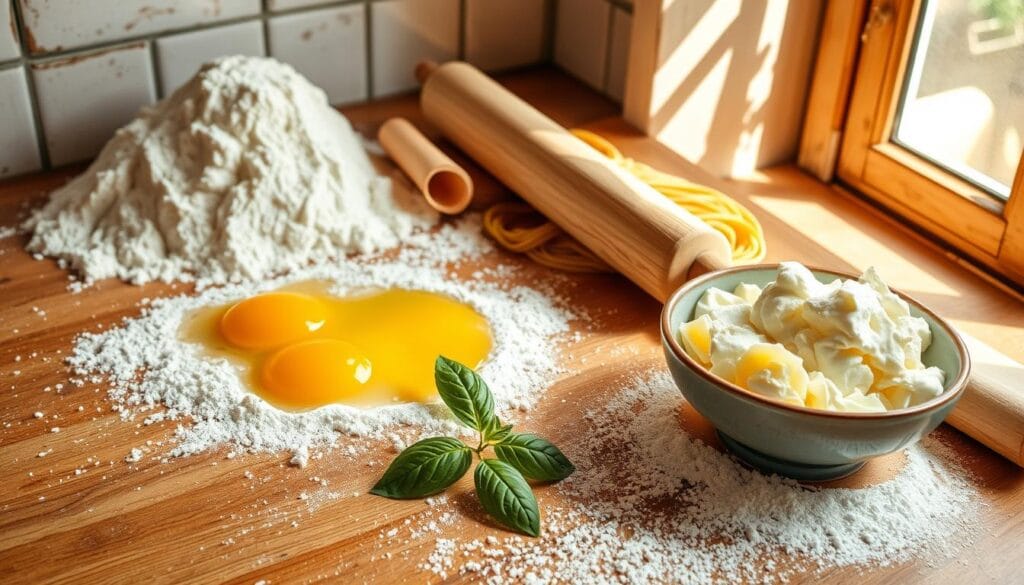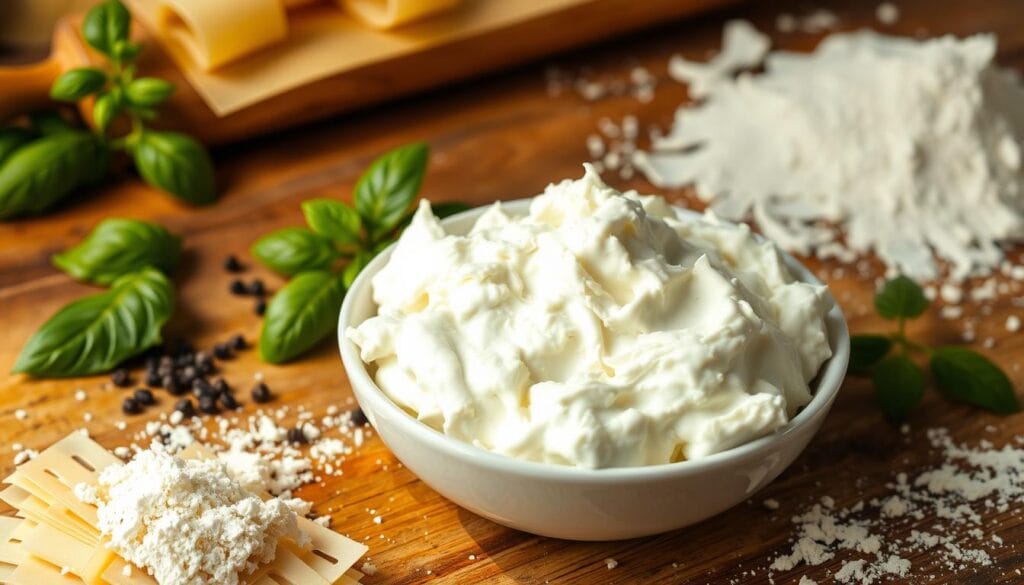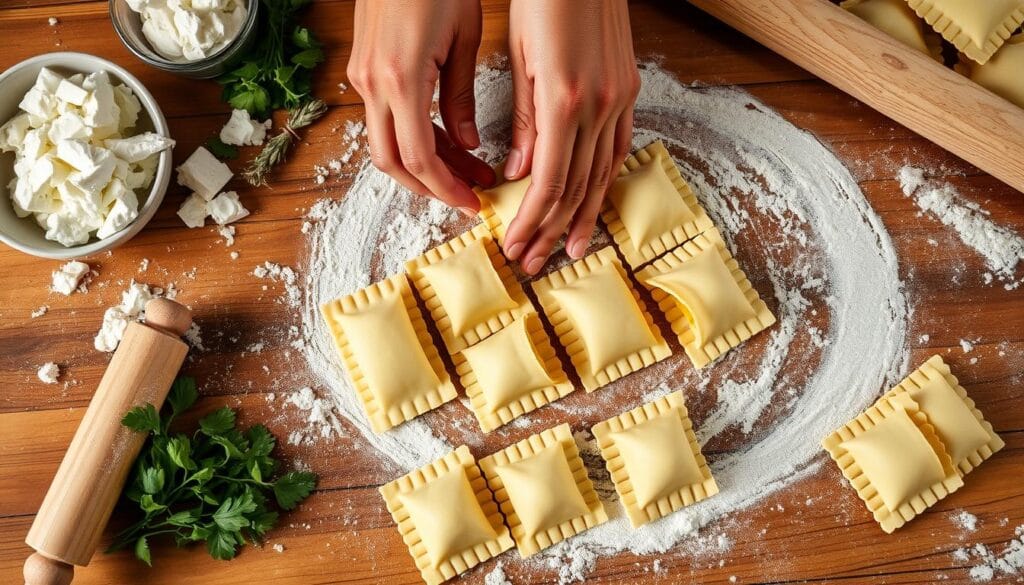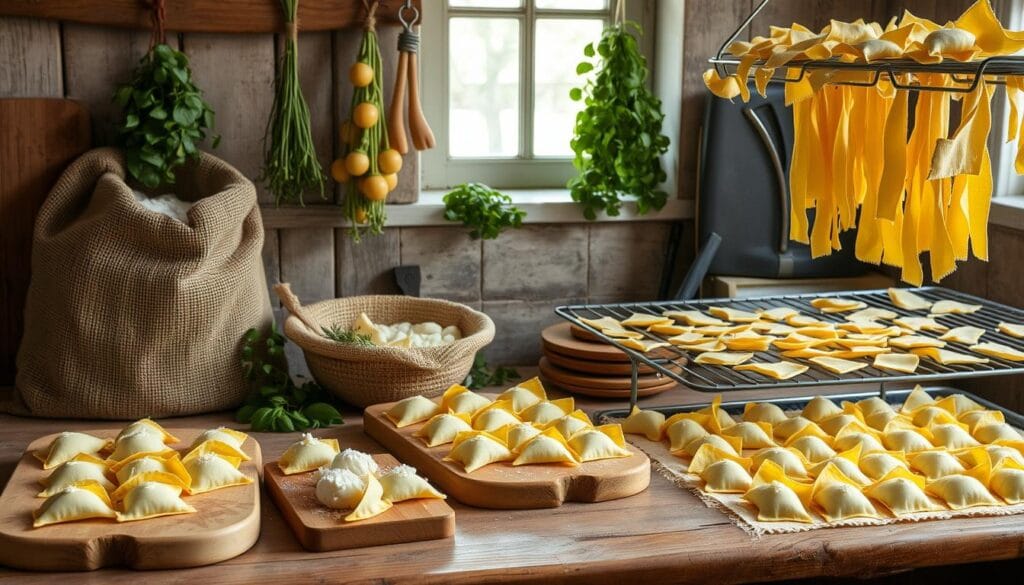Watching my grandmother make ricotta agnolotti was magical. Her hands moved with skill, turning simple ingredients into a work of art. It was a glimpse into Italian tradition and family stories.
Ricotta agnolotti is more than pasta. It’s a celebration of Italian heritage. Each piece is filled with creamy ricotta, melting in your mouth. It brings the warmth of Italian kitchens to your table.
Making ricotta agnolotti is a tradition passed down through generations. From rolling the dough to filling it, every step is a journey into authentic Italian cooking. It’s a way to connect with the soul of Italy.
Table of contents
- Understanding the Heritage of Ricotta Agnolotti
- Essential Ingredients for Perfect Pasta Dough
- Creating the Perfect Ricotta Cheese Filling
- Step-by-Step Guide to Making Agnolotti Pasta
- Mastering the Art of Folding and Shaping
- Classic Sauce Pairings for Ricotta Agnolotti
- Storage and Preservation Methods
- Tips for Cooking Perfect Agnolotti Every Time
- Wine Pairing Suggestions for Your Agnolotti Dish
- Seasonal Variations and Modern Interpretations
- Conclusion
Understanding the Heritage of Ricotta Agnolotti
Ricotta agnolotti is a treasured part of Italian cuisine, filled with centuries of tradition. It comes from the Piedmont region in Northern Italy. There, families have honed its making for generations.
This pasta’s history shows the importance of home cooking in Italy. Families have kept their recipes safe, passing them down through the years. This ensures the true taste and techniques are kept alive.
Origins in Northern Italian Cuisine
In Piedmont, ricotta agnolotti was born as a way to use leftover roasted meats. It was a clever way to reduce waste and add flavor to meals.
- Originated in the mountainous Piedmont region
- Developed as a resourceful peasant dish
- Represents traditional Italian waste-reduction cooking
Traditional Family Recipes Through Generations
“Every fold tells a story of our family’s culinary history” – Traditional Italian Pasta Maker
Each family had its own way of making stuffed pasta. Recipes were kept secret, passed from grandmothers to grandchildren. These traditions turned simple ingredients into unforgettable dishes.
Regional Variations Across Italy
Italy’s different regions have their own versions of ricotta agnolotti. This shows how versatile this pasta is in Italian cuisine.
| Region | Unique Characteristic | Filling Variation |
|---|---|---|
| Piedmont | Classic rectangular shape | Roasted meat |
| Liguria | Smaller, more delicate | Herbs and ricotta |
| Tuscany | Larger pasta shapes | Vegetable-based filling |
Learning about ricotta agnolotti’s heritage is more than just a recipe. It opens a window into Italy’s rich culinary traditions and the diversity of its regions.
Essential Ingredients for Perfect Pasta Dough

Making great fresh pasta starts with knowing the key ingredients of pasta dough. Your journey to making handmade pasta begins with picking top-quality parts. These parts turn simple ingredients into a culinary work of art.
The base of excellent pasta dough is a few important ingredients:
- Flour: Choose 00 flour or semolina flour for authentic texture
- Fresh eggs: Use room temperature, high-quality eggs
- Optional salt: A pinch for enhanced flavor
- Olive oil: Adds richness to your fresh pasta
“Pasta is the canvas, ingredients are your paint” – Italian Culinary Tradition
When making handmade pasta, being precise is key. Your choice of ingredients affects the pasta’s texture and taste. A professional recipe can help you through the detailed process of making perfect pasta dough.
| Ingredient | Quality Indicator | Recommended Amount |
|---|---|---|
| 00 Flour | Fine, powdery texture | 2 cups |
| Large Eggs | Fresh, room temperature | 3-4 eggs |
| Extra Virgin Olive Oil | Cold-pressed, authentic | 1 tablespoon |
Creating pasta dough is an art that needs practice and passion. Each ingredient is vital for the perfect texture and flavor of your handmade pasta.
Creating the Perfect Ricotta Cheese Filling
Making a great ricotta cheese filling is like a work of art. It turns simple cheese ravioli into a dish to remember. The trick is to use top-notch ingredients and find the right mix of flavors and textures.
Selecting Quality Ricotta
Your ricotta cheese filling begins with the best ricotta. Look for ricotta that is fresh, creamy, and has these qualities:
- Smooth, soft texture without graininess
- Bright white color
- Mild, delicate flavor
- Minimal moisture content

Seasoning and Flavor Combinations
Boost your ricotta cheese filling with the right seasonings. Try adding these ingredients for extra flavor:
| Ingredient | Flavor Profile | Recommended Quantity |
|---|---|---|
| Fresh basil | Herbaceous and bright | 2 tablespoons, finely chopped |
| Aged Parmesan | Sharp and nutty | 1/4 cup, grated |
| Black pepper | Warm and spicy | 1/2 teaspoon, freshly ground |
Texture and Consistency Tips
Getting the right texture for your ricotta cheese filling is important. Drain the ricotta with cheesecloth to remove excess liquid. Fold the ingredients gently to keep it light and creamy, without making it too dense.
“The key to an exceptional ricotta cheese filling is balance—each ingredient should complement, not overpower.” – Italian Culinary Experts
Pro tip: Let your cheese ravioli filling rest for 30 minutes before using. This lets the flavors blend together for a better taste.
Step-by-Step Guide to Making Agnolotti Pasta
Making handmade pasta is like creating art. It turns simple ingredients into something magical. Agnolotti, a delicate pasta from Piedmont, needs precision and passion to make it just right.
To start your pasta-making journey, you’ll need a few key ingredients:
- All-purpose flour
- Large eggs
- Pinch of salt
- Olive oil
First, prepare the pasta dough. Make a flour well on your work surface. Crack eggs into the center. Then, slowly add flour, kneading with gentle yet firm motions. Aim for a dough that’s smooth and elastic, bouncing back when touched.
“Great pasta begins with great technique” – Italian Culinary Masters
When making agnolotti, consistency is important. Roll the dough thin enough to see your hand through it. But don’t make it so thin it tears. A pasta machine can help you get the dough even.
- Rest dough for 30 minutes
- Roll into thin sheets
- Cut precise rectangles
- Add ricotta filling
- Carefully fold and seal
Getting good at making pasta shapes like agnolotti takes practice. Don’t worry if your first tries aren’t perfect. Every chef started where you are now.
Mastering the Art of Folding and Shaping
Making perfect handmade pasta shapes needs precision and practice. Agnolotti, a delicate Italian pasta, requires special folding and shaping techniques. These techniques turn simple dough into culinary art.

Knowing the detailed techniques of pasta shapes is key for real agnolotti. Professional chefs say each fold and seal is critical for the dish’s success.
Traditional Folding Techniques
Learn the classic agnolotti folding method with these steps:
- Roll the pasta dough thin and uniform
- Place small ricotta filling portions evenly
- Carefully fold the pasta over the filling
- Pinch edges to create a tight seal
Common Shaping Mistakes to Avoid
Beginners often face challenges in making handmade pasta. Here are common errors to watch out for:
- Overfilling the pasta pockets
- Inconsistent dough thickness
- Improper sealing techniques
- Uneven pasta shape sizes
Professional Tips for Perfect Seals
“The secret to perfect agnolotti is in the details of your fold and seal.” – Italian Pasta Master
Professional chefs suggest using a fork or a pasta crimper for airtight seals. Gently press the edges to remove air pockets. This prevents the agnolotti from breaking during cooking.
| Technique | Difficulty Level | Pro Tip |
|---|---|---|
| Classic Fold | Beginner | Use wet fingertips to seal edges |
| Pinched Seal | Intermediate | Press firmly but gently |
| Crimped Edge | Advanced | Use a specialized pasta tool |
With practice, you’ll master the skills to make beautiful, professional-looking handmade pasta. It will impress even the most discerning Italian cuisine lovers.
Classic Sauce Pairings for Ricotta Agnolotti
Exploring the perfect agnolotti sauce is key in Italian cooking. Pairing ricotta agnolotti with the right sauce makes it unforgettable. It brings out the pasta’s delicate taste.
Italian cuisine has many amazing sauces for ricotta agnolotti. Each sauce adds its own special touch, making the dish unforgettable.
- Classic Butter and Sage Sauce: A light, aromatic choice that complements the ricotta’s creamy texture
- Tomato Basil Sauce: Brings a vibrant, fresh flavor to your agnolotti
- Truffle Cream Sauce: Adds a luxurious depth to the pasta
When picking an agnolotti sauce, think about the sauce’s strength and the pasta’s soft filling.
| Sauce Type | Flavor Profile | Recommended Pairing |
|---|---|---|
| Brown Butter Sage | Nutty, Herbaceous | Light Ricotta Filling |
| Marinara | Tangy, Robust | Herb-Infused Ricotta |
| Truffle Cream | Rich, Earthy | Plain Ricotta Filling |
“The right sauce transforms agnolotti from a simple pasta to a culinary masterpiece.” – Italian Chef Marco Rossi
Pro tip: Warm your sauce gently to keep the ricotta agnolotti’s flavors delicate. The aim is to boost, not bury, the pasta’s subtle taste.
Storage and Preservation Methods
Keeping your fresh pasta fresh is key. Ricotta agnolotti, a tasty handmade pasta, needs special care. The right storage keeps it delicious for longer.

Freezing Guidelines for Fresh Pasta
Freezing is a great way to keep your pasta fresh. Here’s how to do it right:
- Arrange uncooked agnolotti on a baking sheet
- Freeze for 1-2 hours until firm
- Transfer to airtight freezer bags
- Store for up to 4 weeks
Fresh Storage Solutions
Storing pasta in the fridge is all about timing. Your pasta stays best when stored correctly.
| Storage Method | Duration | Recommended Conditions |
|---|---|---|
| Refrigerated (Uncooked) | 2-3 days | Sealed container, lightly floured |
| Refrigerated (Cooked) | 3-5 days | Airtight container |
Reheating Instructions
Reheating pasta gently keeps it tender. Never microwave your agnolotti. Try these methods instead:
- Boil for 2-3 minutes in salted water
- Steam for 3-4 minutes
- Toss with warm sauce just before serving
“The secret to perfect pasta is not just in making it, but in preserving its authentic taste and texture.” – Italian Culinary Tradition
Tips for Cooking Perfect Agnolotti Every Time
Cooking fresh pasta like ricotta agnolotti needs precision and care. Success comes from knowing a few key techniques. These techniques turn these delicate pasta into a culinary masterpiece.
Water preparation is key when cooking fresh pasta. Start with a large pot of salted water, bringing it to a gentle rolling boil. The salt boosts the pasta’s flavor and seasons it from within.
- Use 4-6 quarts of water per pound of fresh pasta
- Add 1-2 tablespoons of kosher salt to the water
- Maintain a consistent water temperature between 185-195°F
Cooking time for ricotta agnolotti is short. Fresh pasta cooks in 2-3 minutes to reach the perfect al dente texture. Overcooking can make the pasta break or become mushy.
“The secret to perfect pasta is respecting its delicate nature and understanding its cooking requirements.” – Italian Pasta Master
When handling fresh pasta, use a slotted spoon or spider strainer to gently remove the agnolotti from boiling water. Avoid aggressive stirring that might tear the delicate pasta.
| Pasta Type | Cooking Time | Water Volume |
|---|---|---|
| Fresh Ricotta Agnolotti | 2-3 minutes | 4-6 quarts |
| Dried Stuffed Pasta | 4-6 minutes | 6-8 quarts |
Pro tip: Always reserve some pasta water before draining. The starchy liquid can help create a silky sauce that clings perfectly to your fresh pasta.
Wine Pairing Suggestions for Your Agnolotti Dish
Finding the perfect wine for your ricotta agnolotti can make your meal special. The right wine brings out the pasta’s flavors, making your meal a true celebration of Italian cooking.
Choosing the right wine is key. Think about the creamy ricotta agnolotti and what sauce it might have. The right wine can make your meal even better.
Red Wine Selections
Red wine lovers have many great choices for ricotta agnolotti:
- Barbera – A light-bodied Italian red with bright acidity
- Dolcetto – Smooth wine with soft tannins
- Pinot Noir – Elegant and versatile red wine
White Wine Options
White wines also pair well with your pasta dish:
- Vermentino – Crisp and refreshing
- Chardonnay – Buttery and full-bodied
- Pinot Grigio – Light and zesty
Regional Italian Recommendations
Exploring Italian cuisine means trying regional wines. Wines from Piedmont are perfect with ricotta agnolotti, showing the pasta’s northern Italian heritage.
“Wine is the poetry of the earth.” – Mario Soldati
Your wine choice should match the pasta’s richness and highlight its flavors. Try different wines to find your favorite!
Seasonal Variations and Modern Interpretations
Ricotta agnolotti is a canvas for seasonal ingredients and new tastes. Italian cooking is all about creativity and tradition. This lets chefs and home cooks make this classic dish their own all year.
In summer, ricotta agnolotti gets a fresh twist:
- Fresh herbs like basil and mint
- Roasted seasonal vegetables
- Light olive oil-based sauces
- Heirloom tomato garnishes
Winter brings richer flavors to ricotta agnolotti. Try these:
- Truffle-infused ricotta fillings
- Butternut squash with the cheese
- Sage brown butter sauces
- Roasted chestnut crumbles
“Seasonal cooking is about listening to nature’s rhythm and translating it onto the plate.” – Chef Mario Batali
Modern chefs are pushing ricotta agnolotti in new directions. They mix global flavors with Italian traditions. This creates dishes that are both new and true to their roots.
| Season | Recommended Filling | Sauce Pairing |
|---|---|---|
| Spring | Ricotta with Spring Peas | Lemon Herb Butter |
| Summer | Ricotta with Roasted Zucchini | Light Tomato Basil |
| Autumn | Ricotta with Pumpkin | Sage Brown Butter |
| Winter | Ricotta with Truffle | Parmesan Cream |
Exploring ricotta agnolotti is a flavorful journey. It’s about tradition and creativity. Let your imagination fill each pasta pocket with new flavors.
FAQ
What exactly are ricotta agnolotti?
How is making agnolotti different from making other stuffed pasta?
What type of ricotta works best for the filling?
Can I make agnolotti ahead of time?
What sauces pair best with ricotta agnolotti?
Are agnolotti suitable for vegetarians?
How difficult is it to make agnolotti from scratch?
What wine should I serve with ricotta agnolotti?
Conclusion
Exploring ricotta agnolotti is more than just a recipe. It’s a journey into the heart of Italian cuisine. This handmade pasta connects you to generations of culinary tradition. It invites you to celebrate authentic flavors and artisan techniques in your kitchen.
Making ricotta agnolotti is a special dance of ingredients and skill. Each fold and seal shares a story of Italian cooking. It brings you closer to the heart of a centuries-old tradition. Though it may seem hard, with practice, you’ll master making these delicate pasta pockets.
Whether you love cooking at home or are a food enthusiast, mastering ricotta agnolotti opens new doors. Your journey doesn’t stop with this recipe. It’s an invitation to explore more of Italian cuisine. Embrace the imperfections, enjoy the process, and savor every bite of your handcrafted masterpiece.
Remember, authentic cooking is about passion, practice, and personal connection. Your ricotta agnolotti is more than a dish. It’s a bridge to tradition, a testament to your skills, and a delicious celebration of Italian heritage.

